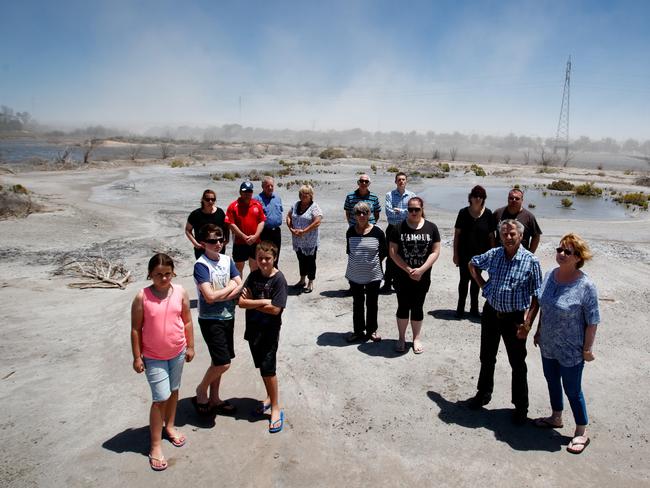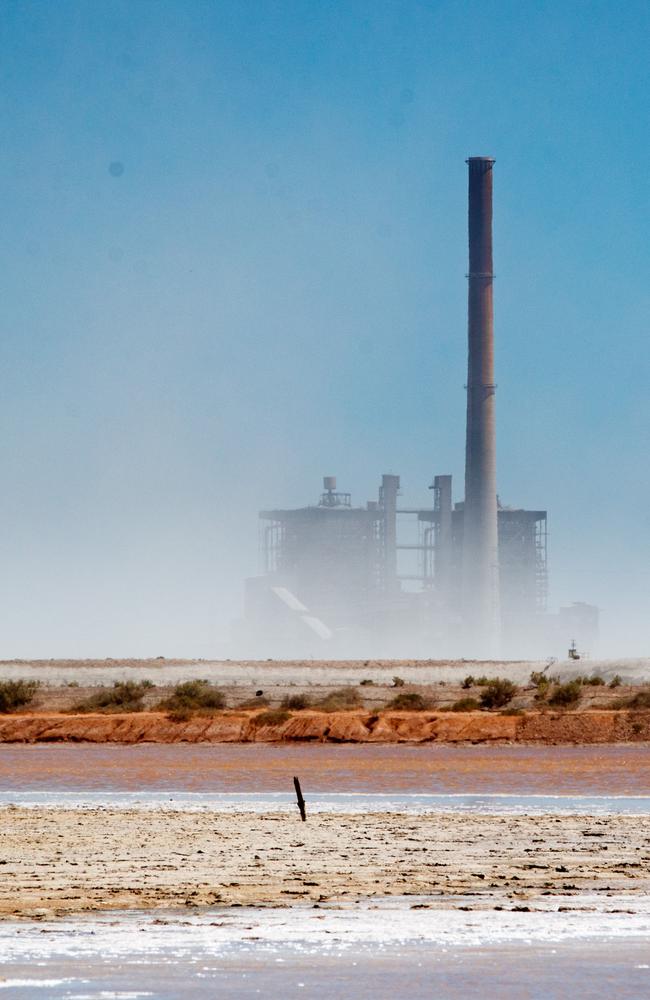Concerns grow over ash cloud at Port Augusta following closure of Northern Power Station
A THICK plume of dust from the defunct Northern Power Station is blanketing Port Augusta and nearby towns, causing breathing problems for residents and putting children in hospital. SEE THE VIDEO
SA News
Don't miss out on the headlines from SA News. Followed categories will be added to My News.
- Final coal train leaves Leigh Creek after Pt Augusta station closes
- Solar power push to keep Port Augusta jobs
- Thermal energy plant likely to win support from $1 billion energy fund
A THICK plume of dust from the defunct Northern Power Station is blanketing Port Augusta and nearby towns, causing breathing problems for residents requiring hospital treatment and sparking health concerns.
Environment Minister Ian Hunter has urged residents to avoid contact with the airborne ash and has ordered the Environment Protection Authority to investigate the plume.
Port Augusta Mayor Sam Johnson said residents were rightly angry about the potentially toxic plume, which he says is “unacceptable” and has forced children to hospital.
He said little had been done to find a permanent fix for the problem despite alerting the EPA and State Government to it on numerous occasions.

The EPA on Monday released a statement saying the ash cloud was “not toxic”.
But late last month it stated recent SA Health tests showed dust at the decommissioned coal-fired station contained “minimal toxic metals and substances” and the “dust particles themselves may cause health effects, irrespective of their elemental make-up”.
The station closed in May last year and Flinders Power, the company responsible for the site, has been applying dust suppressant to its 250ha ash storage area to prevent dust being emitted in windy conditions.
However, the extreme rain and wind that lashed much of SA last week has washed away the suppressant and the storage area has since dried out.
Mr Johnson said recent windy conditions stirred up dust at the site and created a large ash plume on Sunday.
He said dust from the power station had long plagued the region but the ash cloud on Sunday was the worst he had seen.
“Imagine a really big fire with a lot of smoke and you can’t see (through it),” he said.
“From one angle, you can’t actually see the power station.
Mr Johnson said it was “unacceptable”.
“We’ve got thousands of people sucking in this ash right now.”
“We’ve got thousands of people sucking in this ash right now,” he said.
“People are pissed off and they’ve got every right to be — we’ve got children with chronic lung conditions, asthma.

“I’ve had mothers ring me (and say) they’ve had to take their children to hospital to help with their breathing.”
Mr Johnson said the council had alerted the EPA each time a dust cloud formed but nothing had been done to fix the problem.
“So there have been a dozen times the EPA has been alerted and the last two days have been the worst,” he said.
“I have personally text messaged photos and videos to (State Government ministers) so they can’t say they don’t know.”


Health concerns from the plume come at a time the city is grappling with job losses from the closure of the power station.
Air pollution researcher James Whelan, from Environment Justice Australia, said coal ash could contain heavy metals such as mercury but the levels of these toxins in ash dust varied from site to site.
“It really doesn’t matter what those particles are, just the inhalation of those millions and millions of particles is a problem,” he said.
“There isn’t a safe level of exposure to particle pollution.”
Chemical expert Dr Mariann Lloyd-Smith, from the National Toxics Network, said coal ash was renowned for containing mercury and other heavy metals, some carcinogenic.
“Fly ash is the most toxic form of coal ash,” she said.
“I don’t know how you can say it’s non-toxic.”
“Unless the fly ash has had all (chemicals and heavy metals) removed, I don’t know how you can say it’s non-toxic.”
Mr Hunter said he was unaware of specific health risks associated with fly ash but has advised against contact with it.
“It wouldn’t be something we encourage people to be working in or playing in, that’s why we keep a crust on it, but people have experienced some ash being dispersed through the air in recent times,” he said.
“We understand the distress that causes the local community and that’s why I’ve asked the EPA to report to me this week about what we can do about that fly ash.”
Mr Hunter said the EPA report would be completed by the end of the week.
The EPA issued a statement on the matter acknowledging that recent heavy rain had impacted on previous efforts to suppress dust from the former power station.

“As part of a Dust Management Plan, Flinders Power is considering methods to resolve the most recent problem and is keeping the EPA informed of its progress,” it read.
Flinders Power also issued a statement, saying the company was taking immediate action to rectify the dust issue.
“Flinders Power is currently implementing immediate measures for the restoration and management of these exposed areas,” it read.
“Flinders Power continues to collaborate with the EPA, Council and other stakeholders on this issue.”
The company also said dust suppressant had been used as an interim measure but a permanent solution would be rolled out this month.
Residents fear for children’s future
RESIDENTS near the former Northern Power Station fear an ash cloud is putting their health at risk but say their concerns have fallen on deaf ears.
Stirling North resident Michelle Coles, 60, said dust from the power station often drifted into nearby townships but Sunday’s plume had sparked renewed calls for action.
“A lot of people believe they are suffering because of the fly ash,” she said. “It is very much the talk of the town.”
Ms Coles attributed her seven-year-old granddaughter’s asthma diagnosis six months ago to the fly ash.
She said she had been hospitalised twice since then.
“I would like an investigation into what the effects of fly ash does to a community, health-wise and also what it does to the environment,” she said. “They told everyone Maralinga was safe ... I know it’s different, but look what happened there.”
Ms Coles said residents had been complaining to authorities about the ash for a long time. “If we don’t jump up and down and try to do something about it, our children are going to suffer in the years to come,” she said.

Mother-of-two Kellianne Reynolds, also of Stirling North, said the fly ash was “pretty relentless”. “There are plenty of people complaining of sore eyes, coughing and wheezing,” she said.
“We have to think about our future and our future health for our kids and this blowing all over us is quite terrifying. “Would you like your family living with this toxic dust all over your family?”
For grandparents Ian and Irene Slee, the fly ash billowing over Port Augusta had added insult to injury. When the plant shut down in May last year, many employment opportunities disappeared.
“We are very concerned for our grandchildren,” Ms Slee said. “We are worried about their health and about their future here. We are worried they will have to go away to find work and start their lives.”
Two of their grandchildren had recently moved to Queensland and Ms Slee said she was glad they would not be in an environment which could make them sick.
The dust is the product of 62 years of energy production and has residents up in arms.
Port Augusta Mayor Sam Johnson said the dust was a “disgrace” and immediate action needed to be taken by both the State and Federal governments. “We can’t be breathing this in for another week,” Mr Johnson said.
“There needs to be a permanent solution.”


